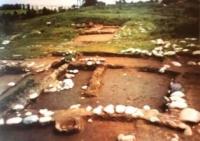You are here
Archeology of Denisov district.

Archeology of Kazakhstan.
"For treason to the motherland, an extreme baseness of the soul is needed"
Nikolay G. Chernyshevsky.
Archaeological expeditions of Kazakhstan.
In the Denisov district of the Kostanay archaeological expedition (V.N.Logvin) in 1971 - 1991, 109 archaeological monuments were identified and put under state protection. Basically, these are groups of barrows, single barrows, settlements, burial grounds dating back to the Bronze Age, Eneolithic Age, the Early Iron Age, and the Middle Ages.
Archaeological excavations were carried out only in the 1960s by the famous archaeologist V.V. Evdokimov, who investigated the Cheraskul settlement of the Bronze Age near the village of Shukubay. The archaeological map of the Denisov region, 4000 years ago, was part of the world famous archaeological "Country of cities" - the most ancient civilization of the Ural-Kazakhstani steppes, dating back to the Bronze Age (XVIII - XVII centuries BC).
It stretched across the territories of modern Russia and Kazakhstan and was inhabited by Indo-European tribes who had their own written language and astronomical knowledge. More than 20 ancient settlements are known, the most studied of which is Arkaim (near the Russian city of Magnitogorsk).
On the territory of the Komarovsky rural district, there is the Pervomaisk settlement - the only known monument of the proto-city culture of ancient Indo-European tribes in Kazakhstan, dating back to the turn of the III - the beginning of the II millennium BC.
Its discoverer, Viktor Nikolaevich Logvin, gave it the name KazArk - Kazakhstan Arkaim. The early stages of the Bronze Age are characterized by settlements with defensive walls and the most ancient fortress cities in the steppe zone, which are known so far only in the Southern Trans-Urals and here, near the village of Pervomayskoye.
This is a unique city-fortress, city-temple, city-workshop, city-observatory, the exploration of which is still ahead and who knows what secrets this mysterious city will reveal to us. The culture of the Country of Cities belongs to one of the most ancient world civilizations.
The Eurasian territory "Country of cities" is a zone of interaction between the cultures of the West and the East.
Ancient valley Tuyemoinak (Camel neck).
In ancient times, millions of years ago, on the territory of our region stretched the huge Turgai Sea, which was a continuation of the ancient Tethys Ocean. The sea then receded, then overflowed again, volcanoes erupted, mountains and hills rose and fell from the depths of the earth, huge horsetails and ploons grew.
Life is born in the sea: the first unicellular organisms appear, then mollusks, shell and cartilaginous fish, mammals. It was then that the most beautiful nature of our native land was formed - rocks, birch and aspen groves, rivers and lakes.
The Tobol River, the most beautiful bends of which, repeating the camel's neck, formed the most picturesque tract, which from ancient times was called "Tuyemoinak" (Camel's neck). The image of a camel played an important role in the ideology of the ancient and medieval peoples of Central Asia.
In the ancient "Avesta" he is compared with a powerful ruler, the embodiment of the god of victory and thunder, Veretranga. During the excavations in Otrar, ceramic vessels made in the form of camels were discovered.
In Khorezm, the crowns of the rulers were made in the form of lying camels. In Bukhara, the murals of the palace depict a ruler on a throne decorated with winged camels. The image of a camel is very often found in the ancient rock art of Kazakhstan: the petroglyphs of Karatau, Bayan Zhurek, Baikonyr, Arpauzen.
Authority:
http://www.museum.denisovka.kz/







